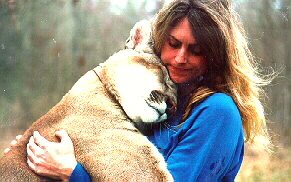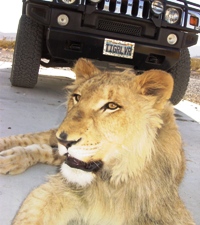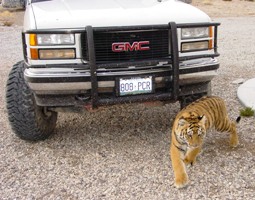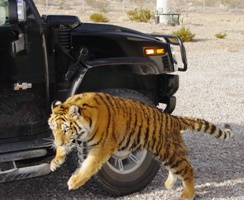Wild Politics of Exotic Animal Ownership
By Zuzana Kukol
Searching for freedom in the 'land of the free’
Growing up as an animal lover in the former communist Czechoslovakia, I often
dreamed about the day I would become free and live my life to the fullest with
very little or no government intervention.
To realize my dreams, I left my home, friends and family at the very young age, and
after spending 1 year in a political refugee camp in Italy, I came to the USA ready to
turn my dream into a reality.
Speaking no English I used my dictionary to learn new words and phrases. This
was in 1986.
A lot has changed since then, some words and terms no longer have the same
meaning and some words and terms have become “politically incorrect”. Some of
these politically incorrect terms are “exotic pet” and “private ownership of
exotic animals”.
Being raised in a heavily political climate of a communist Czechoslovakia, I
saw becoming a US citizen and getting exotic pets as a way to escape the
politics and just relax and live a peaceful life in a free country with my
beloved pets. Little did I know that privately owning exotic animals would be
one of the most political journeys of my life.
Pets are now referred to as “companion animals”, and being a private owner of
exotics is being compared to a form of animal abuse by animal rights (AR)
activists simply because the animals are kept in cages (as required by the law)
and not running free in the wild. The problem is, wild as we know it is quickly
disappearing, and pretty soon the only way for many species to survive in the
future is through captive breeding.
Media throws emotionally charged, one-sided articles and TV news reports at
gullible public, often not researching the subject thoroughly and causing a lot
of damage in the process by not presenting the whole picture.
They fall prey to the animal rights activists’ news
releases that specialize in exaggeration and often don’t bother with facts. The
result is more demands for more unnecessary regulations or bans, describing the
exotic pet owner as a complete idiot unable to learn basic husbandry and being a
threat to our children. Nobody is asking for proof of these claims or that these
false statistics and slogans to be verified and backed up with facts and science
instead of pure fiction and emotionally biased opinions.
Why? How did we get here? Where is the “innocent until proven guilty” approach?
AZA Zoos buddy up to AR extremists
As if this wasn’t enough, AZA (American Zoo and Aquarium Association, lately
also known as Association of Zoos and Aquariums), being blind or too weak to
take a stronger position to the threat they themselves face from the political
AR machine, have joined the bandwagon of attacking private exotic “pet” owners
and turning them into scapegoats.
| We are all in the same boat © Valbuena Photography & REXANO |
Many don’t realizes that AZA is not a government agency; it is a powerful private group accrediting zoos and aquariums that have met certain standards for veterinary care, exhibits, physical facilities, operations, safety, security, finances, staffing, education, conservation and research.
May 2001 AZA publication called ‘Communiqué’ features an article written by Vicki L. Duckett, Program assistant of AZA, titled “Call of the Wild”. It describes, in its first paragraph, mauling incidents by exotics in the private sector, and then goes directly to whining about how some Zoos are asked by irresponsible owners to place their unwanted animals.
In comparison, the same can be said by the private sector against Zoos. People have been attacked, injured and killed and animals escaped in Zoo settings as well, and Zoos themselves produce ‘unwanted’ animals, that they either euthanize or place in the so much hated private sector. Zoos do utilize the private sector for their retired and unwanted exotics.
AR bites the hand that feeds them
Not a month goes by lately without news about AR demanding that Zoos close their elephant exhibits and send their elephants to a Tennessee elephant sanctuary, which just had one of its handlers tragically killed in July 2006 by a former AZA Zoo elephant.
The latest targets are Bamboo and the other elephants from Woodland Park Zoo in Washington state.
While the animal rights group desire to supposedly help captive elephants by closing elephant exhibits might be well-intentioned, it is driven by pure emotion and misinformation, and can be potentially harmful to the elephant.
To quote from the July 21st 2006 ‘The Seattle Times” guest column by Mike Keele deputy director of Oregon Zoo, who has worked with elephants for more than 30 years and Dr. Nancy Hawkes Woodland Park Zoo general curator, specializes in elephant reproductive physiology, assisted reproduction techniques and animal behavior:
“ There is no reason to assume Bamboo would do well at the Tennessee facility, a foreign environment with many more elephants and far fewer people than the home she has known all her life, in a completely different climate than the Northwest. Not only might such a move not be better for her, it could create a very sad and lonely elephant, one that is isolated and reclusive. That's not in Bamboo's best interest.
What Bamboo does need is expert care, which she gets. She also needs daily, frequent interaction with humans, because she is highly bonded to people. Raised at WPZ's Children's Zoo, Bamboo craves the attention of her keepers, and at Woodland Park there is a greater than one-to-one ratio of keepers to elephants, as well as two full-time veterinarians, three vet technicians and other support staff.”
Unfortunately, some AZA Zoos try to appease their AR attackers or even became friends with them. Most notorious is the director of the Detroit Zoological Institute Ron Kagan, who won “2004 PETA proggy award-Peta progress Award” for supposedly making the Detroit Zoo the first zoo to voluntarily close its elephant exhibit for ethical reasons and the eighth U.S. zoo to stop exhibiting elephants in recent years. Kagan was almost fired in 2007 from his $200,000 job when it was revealed he lied about having a Ph.D..
Publicly funded Detroit Zoo, like many others in recent years, has been struggling with funding. According to Detroit Zoological Society officials, city of Detroit no longer can afford to help underwrite the zoo's $22-million budget , so only time will tell if they can make it thru regional tax or do it the American way: fend for yourself.
AZA Political
Action to Secure a Monopoly
June 12, 2003, Dr. Eric Miller, DVM, Director of Animal Health and Conservation for the Saint Louis Zoological Park and a member of the American Zoo and Aquarium Association’s Board of Directors, testified in Congress on behalf of the American Zoo and Aquarium Association (AZA) and American Association of Zoological Veterinarians in support of H.R. 1006, also known as ‘Captive Wildlife Safety Act’, which would amend the Lacey Act to define “prohibited wildlife species” as any live lion, tiger, leopard, cheetah, jaguar, or cougar. The bill declares it a prohibited act, with some exceptions, for any person to import, export, transport, sell, receive, acquire, or purchase in interstate or foreign commerce any of these prohibited wildlife species.
 |
|
| Lynn Culver getting cougar hug Photo by Bart Culver |
This would basically prohibit a non commercial private owner of big cats to move to another state and take their animals with them. Animals are considered property under a US legal system and Federal government is overstepping its boundaries by attempting to regulate non commercial activity by telling public they can not take their beloved animal to another state with them. Miller, in his propaganda ridden testimony, stated that:
”The bill is a logical starting point for addressing the public safety threats posed by the private ownership of certain wild and dangerous animals as pets, as well as the important animal welfare issues associated with the personal ownership of these animals.”
Somehow, the only examples he could use to prove the supposed need for this bill were incidents at two facilities that were already licensed and regulated by federal USDA agency and also on the state level, and would therefore be exempted from the bill he was supporting and trying to pass. It is like mixing apples and oranges, trying to ban orange growers because few apples were bad. How about just going after the bad apples and leave the rest alone?
He also claims that: ”Private ownership of large felids also creates significant public consequences.”
Hmm, interesting, since only 19 people were fatally mauled by big cats between 1990 and now, 2008, that is one death per year. This number includes AZA Zoos as well. None of the deaths were the result of the exotic cats running loose off the owner's or zoo property, all happened to people voluntarily on the property where the animals were kept, be it owners, handlers, employees, friends or visitors wanting to see the animals.
You have a better chance of winning the lottery Jackpot (1 in 13,983,816, all six winning numbers selected) or even the elusive Mega Millions Lottery jackpot (1 in 175,711,536), than being killed by a captive large cat (1 in 297,618,284). But you must visit someone with a large cat to get those odds. Now compare that to deaths by escaped big cats….hmm, can’t find those numbers since nobody ever died as a result of captive exotic cat running loose. Animal Rights groups claim to want more regulation and/or banning ownership of big cats in the name of public safety. The odds just don’t add up.
The bill passed despite the testimony of Matt Hogan, (Deputy Director of the U.S. Fish and Wildlife Service), who were opposing this bill. In Hogan’s own words:
”In sum, while we share the Subcommittee’s concerns about the presence and proliferation of big cats in the pet trade, this bill would provide little additional protection to big cat species in the wild – a high priority for the Fish and Wildlife Service. In addition, it may even fall short of its goal of regulating big cat pet trade. We are also concerned about the Fish and Wildlife Service’s ability to meet the extended enforcement mandate created by this legislation. The new prohibitions introduced in this legislation would need to compete against other Fish and Wildlife Service mission-critical priority activities within the context of the President’s Budget.
Moreover, the mechanism created by this bill appears to provide, at least in some instances, coverage that is duplicative of existing law. The Endangered Species Act (ESA) already prohibits the interstate sale and international trade of tigers, leopards, cheetahs, and jaguars.”
U.S.Fish and Wildlife Service is the agency that will be enforcing the law they themselves opposed once the bill is implemented by them.
Don’t forget nobody’s purrfect
In August 2006, a Sumatran tiger slipped out of her enclosure at the AZA accredited Lowry Park Zoo in Florida and had to be shot dead. The escape was blamed on human/keeper’s error when not properly locking the door on the night house for the tiger Enshala.
AZA accreditation director Denny Lewis was reported saying that their group will look into the incident and that “You can train and train and train and have all the right procedures in place, but once in a blue moon, something happens because of human error”.
I couldn’t agree more, but why can’t the same room for error be accepted in smaller private non AZA facilities, commercial or pet owners?
If this happened to the average private owner, we would have everybody, including AZA and AR, screaming to close the facility and the incident would be used ad nauseam over and over again as a proof and reason why private ownership of exotics needs to be banned. Why this double standard?
And recently, on the morning of December 22, 2006, a clouded
leopard escaped her enclosure from AZA accredited National Zoo in Washington,
DC. A few hours later at 2PM, a female keeper was severely mauled on both arms by
a caged tiger during feeding at another AZA accredited zoo in San Francisco,
California.
The news reported the tiger apparently reached its paws through steel bars and
grabbed the trainer's arms while she was answering questions from the public
after the 2 p.m. feeding.
As reported in Examiner on December 30, 2006, AZA went on another
unprovoked attack against private owners to deflect the blame instead of
accepting the responsibility and stay focused on their problem:
“The reports may show that the procedures were followed, but with wild
animals these things sometimes happen,” said Steve Feldman, spokesman for the
American Association of Zoos and Aquariums, the nation’s accrediting body.
Feldman said the vast majority of injuries from tigers happen to people who keep
the animals as pets, not professionals who work with them in zoos."
And in Colorado on February 24, 2007, a zookeeper was
attacked and killed by a male jaguar 'Jorge' at an AZA accredited Denver Zoo
inside a contained keeper service area inside the Feline Building. On July 14th, 2007, a keeper was attacked in a cage by a
tiger at an AZA accredited San Antonio, TX Zoo. On November 19, 2007, a cheetah
escaped from her cage in St. Louis, MO Zoo.
On December 25th, 2007 female
tiger Tatiana got out of her cage at an AZA accredited San Francisco Zoo,
killing one person and injuring two near her cage. This is the same zoo and
tiger where keeper was mauled one year earlier.
On December 27th, 2007, two cougars were reported missing and later recaptured at an AZA Lincoln Park Zoo In Wisconsin. It appears the cougars were deliberately released by vandals.
On February 10, 2008, a tiger named Mata nipped the tip of the keeper’s finger at the Palm Beach Zoo in Florida. Few days later on February 21, 2008, tiger Berani was discovered wandering around an unsecured area at the Honolulu Zoo in Hawaii.
On May 11, 2008, a keeper at an AZA accredited Toledo, OH
zoo was injured when a tiger reached through a double mesh barrier at an odd
angle and lacerated his chest. Few weeks later, on May 24th, 2008, AZA Detroit
Zoo in Michigan keeper was hospitalized after an attack by a lion. The keeper fought off the
lion with pepper spray. The same day in Indiana, AZA Potawatomi Zoo zoo keeper
Jerry Ellis was attacked by a female Amur leopard in the exhibit's holding area.
AZA zoos in USA currently have around 300 tigers. Nobody knows for sure how many
non AZA captive tigers are in the USA, but estimates go from 5,000 to 15,000.
Since private sector has so many more tigers, it is true we have more tiger
related accidents number wise. We are also more hands on and many of us have
full contact with the big cats during cage cleaning and training sessions..
(Note the SF tiger accident happened to the person NOT in the cage with tigers).
However, it is possible that
rate of fatal accidents
per tiger might be actually
higher at no contact AZA zoos compared to private sector since our private
animals are tamer. But without having the exact number of privately held tigers,
we can not calculate the exact rate of injury in private vs. AZA zoo sector. So
I would like for AZA to stop bashing us until they have factual proof
instead of
assumptions.
The Man who loves to growl about Tigers
Talking about tigers, lets not forget Mr. Ron Tilson, director of conservation at the Minnesota Zoo and coordinator of the American Zoo and Aquarium Association’s captive breeding program for tigers, who too has been known to spout AR propaganda based on pure magic and estimates, such as” "Trafficking in endangered species is third only to trafficking in narcotics and gun smuggling".
Hmm, well, according to United Nations, it is human trafficking, not animal trafficking, that is third in line.
Maybe we need to have a boxing mach in Las Vegas: United Nations vs.Tilson (not to be confused with Tyson who also has a tiger fetish) to see who comes third?

Reading news reports interviewing Tilson, it is obvious he doesn’t hide his disgust with private owners of tigers: “…Tigers represent everything fine and decent and powerful. Everything those people would like to be. It’s all an ego trip—big guns, big trucks, and big tigers” and “For private owners to say, ‘We’re saving tigers,’ is a lie,”. He adds: “They are not saving tigers; they’re breeding them for profit”.
Saving Species in Captivity?
MN Zoo’s ‘Tiger Handbook’ says:” Noah saved the animals two by two. Zoos need to save hundreds or thousands of each species to ensure a healthy population. But "zoo arks" are limited in size and resources, so space is at a premium. So zoos must aim for quality over quantity when breeding animals. The goal is to maintain genetic diversity--the richest and purest genetic pool for each species.”
Well, US Zoos manage 3 tiger subspecies with max target population of 150 individuals for each of them. However, what the AZA zoos fail to tell the American public is that only the Siberian tiger has reached that target goal of 150 individuals. The population of other two sub-species pure tiger collections only number in the few dozen, hardly a survival plan. how long will it take before they start inbreeding? You don’t have to be a geneticist to figure out that if you only had 150 humans to save human race, pretty soon we would all look the same, not to mention health issues where any single disease would wipe us all out. With AZA Zoos having all the financial and cage space problems, why can’t the Zoo community look at us, private owners, as the answer/solution to their own as well as conservation problems instead of ridiculing us any chance they get???
Another attack on self sufficient private enterprise from Tilson (and Philip Nyhus, Colby College) came in DECEMBER 2005 AZA CommuniQué magazine in MEMBERS’FORUM -THE TIGER SSP: ZOOS, PRIVATE OWNERSHIP, AND ACCREDITATION: “The Right Thing to Do”.
It appears they want to make everybody who wants to join AZA support legislation against private ownership, in their own words:”We suggest that AZA expand its accreditation process to include an evaluation of each zoo’s participation toward educating the public, supporting legislation, and providing information at state and federal levels to raise the standards of care of privately owned exotic animals.”
Some AZA accredited Zoos might be privately owned, however, the typical AZA Zoo’s funding comes from a mix of public&private donations.
Mr. Tilson’s anti private ownership stance shouldn’t be surprising considering he works for one of one of only two state-run zoos in the USA. Big daddy pays for everything, so his welfarist attitude is understandable but not welcomed in this country, the land of the free, the land whose success is based on the private ownership and entrepreneur spirit. It is private business that made this country great and self sufficient, not people receiving handouts from the government and living off other peoples taxes.
Just last year in 2005, Minnesota Zoo Officials were saying that more state funding is urgently needed. Maybe it is time to change and switch to free market approach where you have to earn your living, just like most of us exotic animal owners do?
A voice of reason in a sea of emotion
It is time AZA Zoos
stopped the ‘us against them’ hypocritical rhetoric which is echoed in May 2001
Communique’ by Steve McCusker, Director of the San Antonio Zoo, that “he wouldn’t be in the business now if he
didn’t own wild animals as a child. He notes it would be hypocritical of him to
reprimand others for doing the same. “
We can never know which child or exotic pet owner will be our next
conservationist, zoo director or biologist.
Only thru close personal contact can we really understand and appreciate these
wonderful creatures. It cannot be taught through books, but only “hands-on”
experience.
To say it in the words of Steve McCusker: “…his individual relationship with these
animals is what motivated him to pursue a life-long career caring for and
protecting both native and exotic wildlife”.
We need more people like Mr. McCusker who are not afraid to acknowledge their
roots.
It is time we all ignored our differences and concentrated on what brings us
together, love for wildlife and desire to protect it for the future generations.
We all need to fight together for our rights to keep the private ownership of
exotics legal.
Privately bred and manufactured in America

As for me, well Mr. Tilson, let me address your comment:“… It’s all an ego trip—big guns, big trucks, and big tigers.”
I own the complete big trifecta: guns, trucks and tigers, and it has nothing to do with an ego. As a single woman living alone in the country with wild animals at the end of the dirt road, I need my guns for protection and my trucks to drive home and to tow trailers with animals and supplies. I am so busy taking care of my animals, fighting for my right to keep them and defending myself against people like you, that I simply don’t have time for any trips, that includes an ‘ego trip”. And since I am a woman, I don’t have to worry about my ‘manhood’ image when driving a big truck and using big guns.

Maybe Mr. Tilson ought to get himself a big gas sucking American Hummer, turn on the stereo to the tune of “Cat Scratch Fever” and spend the day with a true American icon and successful business man Ted Nugent who made it as a rock icon and private animal owner on his own, without any government support. These are the people we need to look up to and celebrate, people with true American spirit who don’t tell others what to do, don’t criticize and don’t suck taxpayers funds.
(NOTE: This article was originally written in 2001 and revised in 2008. REXANO no longer supports Ted Nugent, because of his hypocrisy that was revealed in 2011: OK for him to keep his captive potentially dangerous hoof stock and hunt it, but not OK for American citizens to keep exotic animals commercially or as pets?)
|
Originally published 2001 Revised 2008 & 2012 Copyright © Zuzana Kukol www.REXANO.org
|